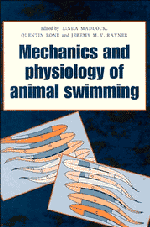Book contents
- Frontmatter
- Contents
- Contributors
- Introduction
- 1 Functional patterns of swimming bacteria
- 2 Buoyancy and swimming in marine planktonic protists
- 3 The role of fins in the competition between squid and fish
- 4 The biology of fish swimming
- 5 Swimming physiology of pelagic fishes
- 6 The mechanical design of the fish muscular system
- 7 How do fish use their myotomal muscle to swim? In vitro simulations of in vivo activity patterns
- 8 The timing of lateral muscle strain and EMG activity in different species of steadily swimming fish
- 9 Swimming in the lamprey: modelling the neural pattern generation, the body dynamics and the fluid mechanics
- 10 Swimming capabilities of Mesozoic marine reptiles: a review
- 11 Stone, bone or blubber? Buoyancy control strategies in aquatic tetrapods
- 12 Functional anatomy of the ‘flight’ apparatus in penguins
- 13 Energy conservation by formation swimming: metabolic evidence from ducklings
- Bibliography
- Index
5 - Swimming physiology of pelagic fishes
Published online by Cambridge University Press: 05 March 2012
- Frontmatter
- Contents
- Contributors
- Introduction
- 1 Functional patterns of swimming bacteria
- 2 Buoyancy and swimming in marine planktonic protists
- 3 The role of fins in the competition between squid and fish
- 4 The biology of fish swimming
- 5 Swimming physiology of pelagic fishes
- 6 The mechanical design of the fish muscular system
- 7 How do fish use their myotomal muscle to swim? In vitro simulations of in vivo activity patterns
- 8 The timing of lateral muscle strain and EMG activity in different species of steadily swimming fish
- 9 Swimming in the lamprey: modelling the neural pattern generation, the body dynamics and the fluid mechanics
- 10 Swimming capabilities of Mesozoic marine reptiles: a review
- 11 Stone, bone or blubber? Buoyancy control strategies in aquatic tetrapods
- 12 Functional anatomy of the ‘flight’ apparatus in penguins
- 13 Energy conservation by formation swimming: metabolic evidence from ducklings
- Bibliography
- Index
Summary
A large, portable water tunnel has permitted insight into the swimming physiology of sharks and tuna. Tunnel use has demonstrated the capacity of sharks to sustain swimming speeds of over one body length per second. This level of aerobic performance for sharks and the measured rates of oxygen consumption during swimming both exceed previous estimates for this group, and are similar to values reported for bony fishes. By permitting studies with stably swimming, instrumented sharks, the tunnel has enabled experimental analyses demonstrating the vis a tergo cardiac filling mechanism and the role of the pericardioperitoneal canal in facilitating rapid changes in cardiac stroke volume. For tunas, the tunnel has permitted long-term and replicate studies of metabolic rate and factors affecting it (temperature, body size, velocity), of heat transfer, and of swimming kinematics. With the incorporation of anaesthesia and surgical techniques it is now possible to investigate tuna cardiorespiratory responses to changes in temperature, oxygen, and swimming velocity, and to carry out biomechanical studies that include the timing of electromyograms at sites along the body, and measurement of muscle force generation in the lateral tail tendons during swimming.
INTRODUCTION
A major focus of our laboratory has been the development of a large volume, portable, high-speed water tunnel respirometer to study the swimming performance and physiology of fishes such as tunas (Figure 1) and many sharks. Prior to the completion of this unit there had been no studies of shark swimming capacity (Graham et al, 1990) and only a few studies of tuna swimming performance (reviewed in Dewar & Graham, in press a).
- Type
- Chapter
- Information
- The Mechanics and Physiology of Animal Swimming , pp. 63 - 74Publisher: Cambridge University PressPrint publication year: 1994
- 4
- Cited by



